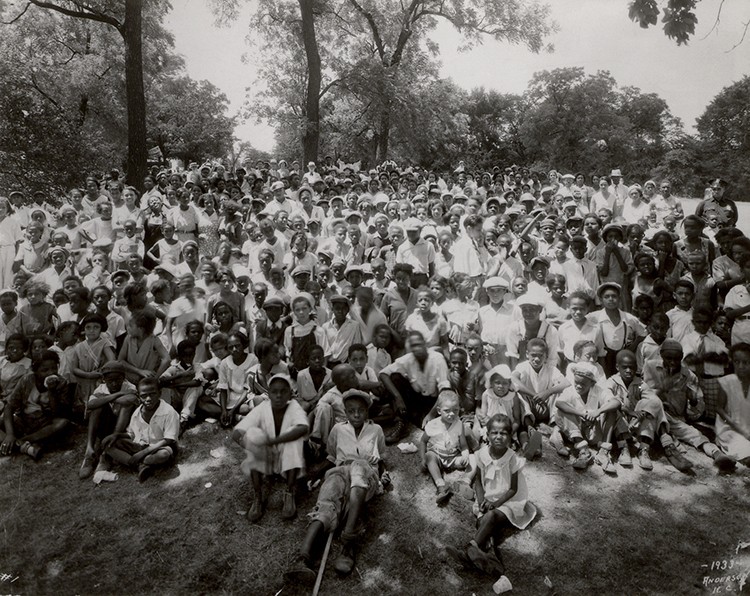Swope Park Shelter #5
Introduction
Text-to-speech Audio
Situated at the edge of a parking lot near the Kansas City Zoo, Swope Park Shelter #5 is an unassuming building consisting of rough stone brick pillars supporting a shingled roof over six picnic tables. However, the unexciting appearance of Shelter #5 hides a history that is inextricably linked with the history of racism in Kansas City. For much of its existence, Swope Park was a segregated amenity, with Shelter #5 being the only park shelter that was available for use by the city's Black population. Though it is unclear where the name first developed, Shelter #5 and the surrounding grassy area garnered the nickname "Watermelon Hill". For better or for worse, this divisive moniker became a lasting memory for many African-American people, making Swope Park Shelter #5 an indelible part of the Kansas City landscape.
Images
Picture of park-goers at Swope Park Shelter #5. Date and Photographer unknown.

Backstory and Context
Text-to-speech Audio
Consisting of rough stone brick pillars supporting a shingled roof over six picnic tables, Shelter #5 is positioned along Zoo Drive, with Starlight Theater to the northwest and the Kansas City Zoo to the east, across a parking lot. According to the African-American History Trail of Kansas City, Swope Park Shelter #5 was constructed sometime between 1940 and 1942 as part of a Five-Year Plan established by the Kansas City Parks Board and the Works Progress Administration, which also included the now-defunct Shelter #8. Unfortunately, as with many of Swope Park's amenities established during this time and earlier, the shelters of Swope Park were segregated. The majority of the shelters were only available to white patrons, with Shelter #5 being provided for Black park-goers to use under the "separate but equal" principle. Regardless of these restrictions, Swope Park enjoyed extensive Black patronage. According to historian Joelouis Mattox, "Swope Park was a “get-away place” from the confinement bounties of the Black community which were 9th Street to 27th Street, Troost Ave. to Benton Blvd." (K. C. Parks)
Over time, Swope Park Shelter #5 and the surrounding area garnered the nickname "Watermelon Hill". According to Joelouis Mattox, the name originates from the watermelons brought by park-goers, which were kept cool in tubs of ice and consumed as part of picnics or eating contests. (K. C. Parks) Mattox also states that there was a great deal of divide about the site among the Black community. One side of the debate refused to use the area, believing that the shelter's racist moniker and location near the Zoo turned the crowds of Black patrons into another exhibit for white park-goers to gawk at. Others, however, disregarded the stares and names to take advantage of an otherwise peaceful and relatively well-appointed area of the park. Mattox relates stories of cookouts, pickup sports games, and casual gatherings of all sorts, as well as many older people who have fond memories of the spot to this day.
Shelter #5 was desegregated along with the rest of Swope Park in the 1950s. To this day, it continues to serve as a gathering place for the denizens of Swope Park and Kansas City, all while paying silent tribute to a little-known facet of the Metro's historic racial divide.
Sources
Hamm, Josh. “Swope Park Shelter #5.” African American Heritage Trail of Kansas City. Accessed December 5, 2022. https://aahtkc.org/swope-park-shelter-5.
Mattox, Joelouis. “‘Watermelon Hill’ Is a Landmark.” Kansas City Parks, October 29, 2013. https://kcparks.org/watermelon-hill-is-a-landmark/.
Missouri State Archives
